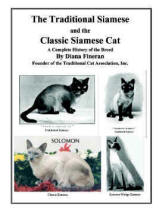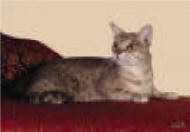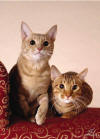TRADITIONAL OCICAT©® (OC)
TRADITIONAL TABBY OCICAT©®
(AKA, JUNGALA)
(OCJ) FAQs
Link to Traditional Ocicat
Breeders Listing
HISTORY - PERSONALITY - HEALTH
Copyright © Diana Fineran, January 2, 2007
Photos Courtesy of Laurie of AbbysAngels
TRADITIONAL OCICAT HISTORY
This magnificent, agouti, spotted cat originated by mixing
the Abyssinian, Siamese and American Shorthair breeds to become the only spotted
breed selectively bred to mimic the cats of the wild.
The very first, original Traditional Ocicat was
unexpectedly produced in 1964 as a result of an experimental breeding between an
Abyssinian and a Siamese. The goal
was to produce an Aby-Point Siamese, but an ivory kitten with golden spots and
striking copper eyes was a surprise. Breeding a totally domestic cat, resembling
a jungle cat was not the goal! The breeder was Virginia Daly from Berkley, Michigan.
The breeds name came about due to their resemblance to the ocelot!
The origin of the breed was started by breeding Dalai Deta
Tim of Selene, a male, Ruddy Abyssinian to a large, Seal Point, Siamese. female
named, Dalai Tomboy Patter. All the kittens in the resulting litter looked like
Abyssinians. Mrs. Daly used only one
female from that litter, Dalai She, a ruddy Abyssinian colored hybrid, who was
bred to CH. Whitehead Elegante Sun, a large, well muscled, Chocolate Point
Siamese with dark coloring. In all of their litters Abyssinian Pointed Siamese
were produced along with Lynx Point, Mackerel Tabby, Classic Tabby and solid
black kittens. In their second
litter of seven kittens an unexpected, spotted kitten was born.
Tonga, the first of the breed, was
neutered, sold as a pet to a medical student named Thomas Brown for $10.00. Only
once was Tonga
presented at a cat show in Detroit
on February 20-21, 1965 in an exhibit of 16 cats billed as “breeds of the
future”. The gorgeous spotted Tonga was then publicized in the Detroit newspaper.
Daly read an article by Dr. Clyde Keller of Georgia
University and wrote to him about Tonga.
The Dr. became interested in the breed, so the original breeding was
repeated to produce more spotted cats! His goal was to produce cats similar to
the now extinct “Egyptian Spotted Fishing Cat”. Other
breeders followed using a broad genetic source. The introduction of the American
Shorthair counter acted the Extreme Wedge Siamese characteristics by adding
substance to the body, good boning and the silver gene.
The Dalai Cattery, owned by Virginia Daly, re-focused its
efforts toward the Traditional Ocicat breed. Tonga’s dam, Dalai She and her sire,
Sunny were bred again and produced the Tawny son, Dotson.
Darwin, Aruby and Jobecua Catteries joined the breeding efforts.
Produced were Darwin Vierdalai of Dalai, who sired Dalai Golden Phoenix
and Dalai Sequin. One of their
decendants, Dalai Golden Cavalier of Ociville was the breeds first Grand
Champion.
This was the first
effort to breed an entirely domestic cat that presented the spotted beauty of
wild cats, yet maintained the docile nature of the domestic cat.
TRADITIONAL TABBY OCICAT (AKA JUNGALA)
This is a Traditional Ocicat in every way except it comes
in the Classic Tabby Pattern, without spots. They display all the majesty and
clarity of the Classic Tabby Pattern of an American Shorthair, from which part
of their ancestry originates. Their breeding, conformation and temperament are
exactly the same. Their name was taken from the Sanskrit word for “Jungle”.
Since they come from the result of allowable outcross
breeds between recognized breeds, the Traditional Ocicat and the Traditional
Tabby Ocicat (AKA Jungala) can be mated together with the resulting kittens
being registered as the “selected breed”.
PERSONALITY
They steal the hearts of those fortunate enough to own one.
Even though they look “wild” their
temperament is not ferocious. In dog
like fashion, they are absolutely devoted to their humans with their agreeable
and amenable character. Instead of
being demanding and clinging, they are confident, dedicated and quite
extroverted toward strangers. They joyfully check any new person in their
household, and are not bashful to climb up to curl into a new lap. So loving
toward human inter action, they will follow their humans from room to room to
see what’s new! Active and
talkative, they are the perfect choice for those who love interactive cats.
Intelligent, affectionate, athletic, curious, clever
and mentally bright, they can be easily
trained to fetch, walk on a leash, respond to voice directions, enjoy traveling,
and easily adapt to home rules. Some learn tricks and willingly perform them to
an appreciative audience. Their
social nature makes them a good match to a home with other pets. Because of
their dependency upon companionship they may not be the best choice for a single
cat. They don’t thrive in isolation.
Their temperament and adaptability make them a truly
enjoyable, loving companion and a welcome addition to many households.
HEALTH
There is no special care needed for these easy keepers.
Their short coats need only the occasional grooming.
Their broad genetic back ground gives them health, vigor and vitality, so
they are not prone to any particular health problem. Genetic anomalies or
problems associated with inbreeding have been avoided due to such a diverse
genetic base. Females are easy to
breed and experience few birthing problems. Litter sizes are constant and
kittens are very playful.
Top
|
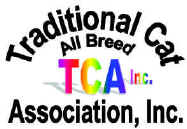
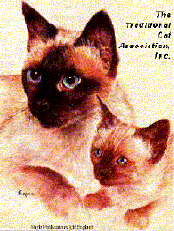 The
Traditional Cat Association,
Inc.©1987®TM
Official Website
The
Traditional Cat Association,
Inc.©1987®TM
Official Website